How to Make Your Own Air Freshener for Car?
It’s easier than you think — and a lot more satisfying. A DIY freshener lets you pick your scent, match your car’s vibe, and save a few bucks while you’re at it. For a deeper dive on durability and scent strategies, see this guide to diy car air fresheners that last.
It’s kind of like brewing your own coffee — once you’ve nailed your blend, you’ll never go back to servo sludge. With a few simple ingredients (think essential oils, felt, or timber beads), you can make something that lasts longer and smells like you, not a plastic pine tree. If you prefer a step-by-step tutorial format, check out car air freshener DIY.
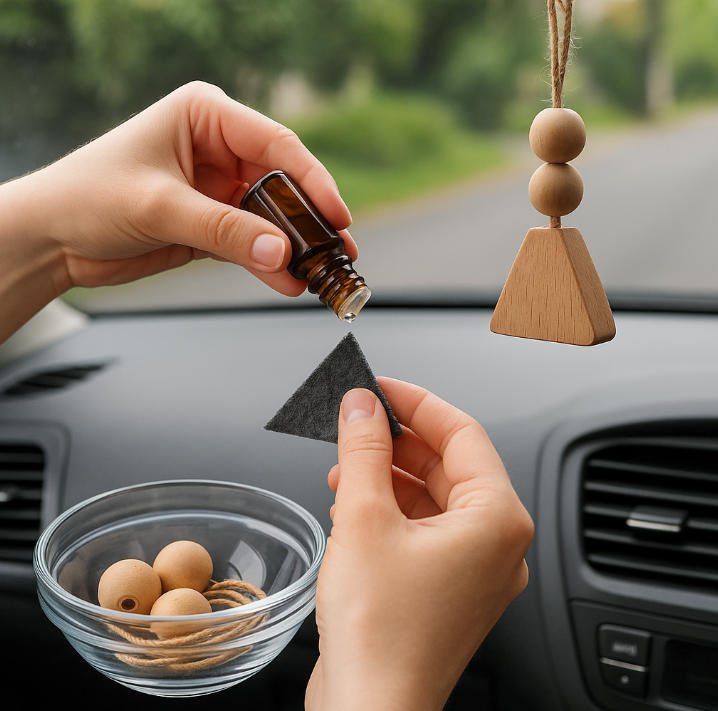
“People are leaning into homemade goods because they’re more sustainable and personal,” says Aussie eco-living blogger Sarah Lewis. And when your car smells like a rainforest or a vanilla latte? That’s just a bonus.
DIY or store-bought?
When comparing diy air freshener recipes to store-bought air freshener brands, it feels a bit like choosing between home-cooked dinner and takeaway. Both get the job done, but one lets you control exactly what goes into it. For an overview of categories and use-cases, AllGoodsHub’s primer on custom car air fresheners is handy, and broader buyers can skim car air fresheners.
We spoke with Lauren Casey, a certified environmental chemist in Brisbane, who shared, "Many commercial air fresheners contain phthalates and synthetic musks. These are linked to respiratory irritation, especially in small, enclosed spaces like cars." She added that DIY options using natural ingredients such as essential oils and baking soda offer a safer, low-tox choice without sacrificing freshness. Independent research reviews on fragranced products document reported respiratory and mucosal symptoms associated with exposure to air fresheners; see the open-access analysis of fragranced consumer products published in Air Quality, Atmosphere & Health (peer-review summary) and recent discussions of synthetic fragrance chemicals and endocrine activity (2024 review).
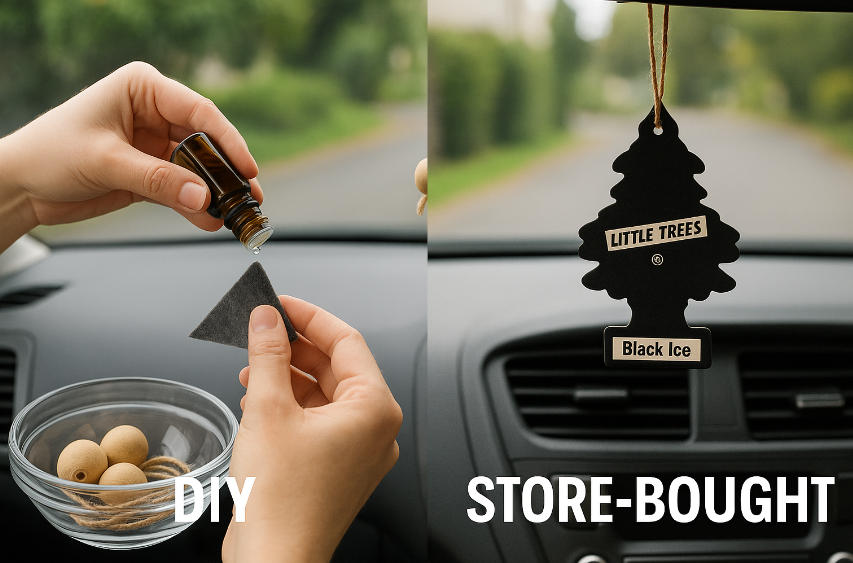
Some drivers prefer store-bought fresheners for convenience. Brands like Little Trees or Ambi Pur offer strong scents and long-lasting performance, although the chemical composition can be harsh for sensitive noses. In contrast, DIY blends made from tea tree or citrus oils may need topping up weekly but are friendlier on both health and the planet. If you do go ready-made, you can still choose curated options like Little Trees Black Ice Hanging Air Fresheners 6-Pack or the New Car smell air freshener 3 pack, and compare against vent clips such as Unstopables car vent clip.
Quick comparison:
Cost comparison: DIY wins long-term (supplies can make multiple refills).
Scent customisation: DIY allows personal blends, store-bought is fixed.
Longevity: Store-bought lasts longer, DIY is refillable.
Environmental impact: DIY uses reusable materials, less waste.
When it comes to trust, DIY fresheners may not carry big-brand packaging, but many crafters share design process videos, user reviews, and even eco-certifications from local suppliers. That transparency builds confidence beyond the shelf. If you care about safety and regulation in Australia, note that fragrances used in consumer products are regulated as industrial chemicals under AICIS; see official guidance on flavour and fragrance chemicals.
Air freshener base types
The base you choose for your DIY air freshener affects not just the scent—but how long it lasts and how it behaves in your car. For background on each type and which projects they suit, this AllGoodsHub explainer on homemade air freshener recipes is a good companion.
Carrier oils for long-lasting scent
Carrier oils like jojoba oil, almond oil, and fractionated coconut oil are go-to bases when you're chasing a slow and steady scent release. These oils dilute essential oils while holding onto fragrance for weeks, making them ideal for felt diffusers or timber beads.
Pro tip: “Jojoba mimics the skin’s natural oils, which helps with scent longevity,” says aromatherapist Lara Goodman.
Baking soda as a scent absorber
Baking soda is the old-school legend of odor control. It doesn’t just mask smells — it neutralises them. Perfect for small jars with holes poked in the lid, this base is a budget-friendly fix for stinky gym gear or spilled Maccas fries. Chemically, sodium bicarbonate can neutralise acidic or basic volatile compounds, which helps reduce perceived odour intensity (see the American Chemical Society’s plain-language explainer, “The Science of Baking Soda” and a concise Q&A on its amphoteric deodorising action from Chemistry Stack Exchange discussion).
Absorbs moisture and neutralises household odors
Pair with 10–15 drops of essential oil for fragrance
Ideal for cupholder jars or boot compartments
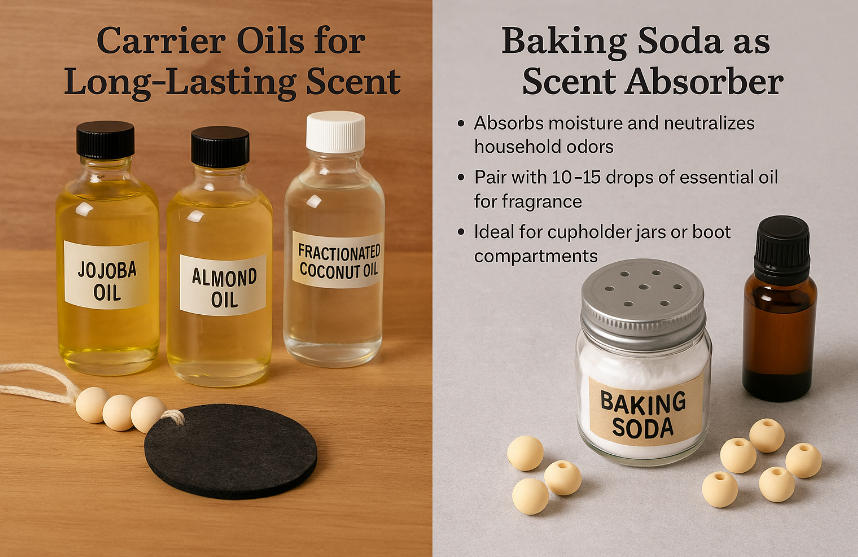
Alcohol sprays for quick freshness
When your car’s starting to smell like yesterday’s takeaway, alcohol sprays are your best mate. Just grab a spray bottle, mix isopropyl alcohol or vodka with water and essential oils, and give the seats a mist. Typical DIY room-spray ratios use a higher proportion of alcohol to help solubilise oils and speed evaporation; a common pattern is 2 parts alcohol to 1 part water, then essential oils (see representative aromatherapy guides and DIY formulations consistent with industry practice; always patch-test fabrics).
Mix 2 parts alcohol with 1 part water
Add 15–20 drops of essential oils
Spray lightly over fabric seats or mats
This method gives you quick freshness, great after a long road trip or rainy-day dampness.
Gel-based bases for slow diffusion
For those who love a bit of craft and patience, gel-based bases offer slow scent diffusion and a quirky DIY edge. Made with gelatin or agar-agar, the gel traps your favourite essential oils and releases them bit by bit. (Gel diffusion projects are a staple in DIY communities; ensure food-grade gelatin/agar and keep out of direct sunlight in hot cars.)
| Base Type | Diffusion Rate | Fragrance Longevity |
|---|---|---|
| Gelatin | Slow | 3–4 weeks |
| Agar-agar | Slower | 4–5 weeks |
These work well in sealed containers with vented lids — great for cup holders or under the seats.
Freshener shapes and styles
Choosing the right shape for your DIY air freshener isn’t just about looks — it affects how it works. Let’s break down the most popular styles. If you decide to personalise or gift them, browse AllGoodsHub’s custom printed air fresheners to see common formats used in the industry.
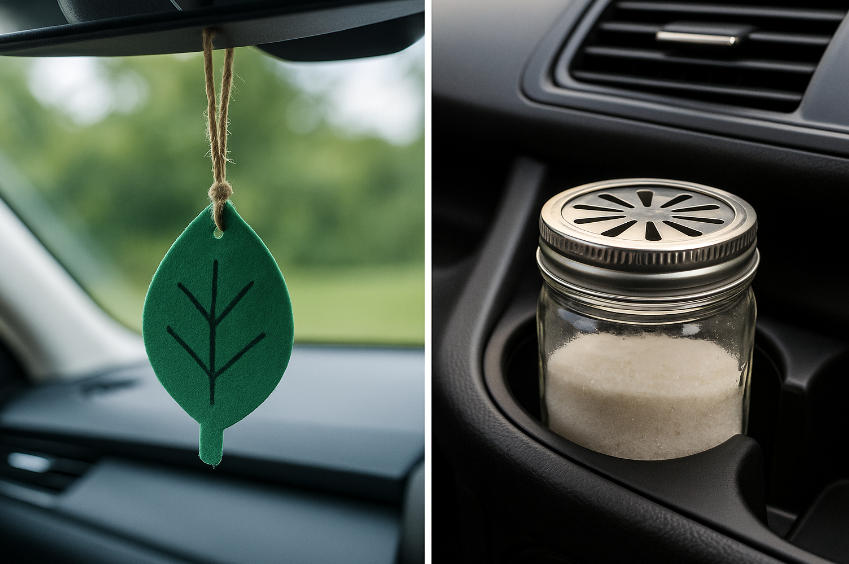
Hanging felt cutout designs
These classic DIY air fresheners are all about customisation and simplicity. Cut felt into your fave shapes — leaves, stars, even footy jerseys — then soak them with essential oils. If you’d rather have them professionally printed and scented, you can order custom logo car air fresheners Australia.
Easy to hang from your rear-view mirror
Great for kids or crafty types keen on design
Felt absorbs and slowly releases scent
Doubles as car decoration, like a soft lampshade for your nose
“Felt is cheap, easy to cut, and holds oils really well,” says Mel Norton, a Melbourne-based craft tutor.
Timber bead diffusers with ribbon
For a more stylish, earthy vibe, timber bead diffusers are a top pick. String a few beads onto a ribbon and add a few drops of oil — they absorb slowly and last ages. If you’d like pre-made options while you experiment, see personalized scented car air fresheners.
Choose unfinished timber beads (better oil absorption)
Thread them with natural cotton or hemp ribbon
Tie around your mirror or vent
Add 10–15 drops of essential oil
Reapply weekly or as needed
It's like giving your car its own mini wood-lamp shade, and they look classy as.
Mason jar vent lid styles
If you’re into glass, recycled materials, and low-key designs, mason jars with vented lids are the way to go. Perfect for holders in cup compartments or tucked under seats. For inspiration on scent families that suit this style, see AllGoodsHub’s overview of car air fresheners.
| Material | Scent Diffusion | Reusability |
|---|---|---|
| Glass Mason Jar | Moderate | High |
| Metal Vent Lid | Good | Long-lasting |
| Baking Soda/Oil Base | High | Easy Refill |
DIY lovers rate these for being eco-friendly, clean-looking, and easy to refill — just pop the lid and add more scent.
Best essential oils for driving
Choosing the right essential oils can turn your car into a calming, energising or clean-smelling space — without being overwhelming. For a comparison of fragrances typically used in automotive fresheners, explore AllGoodsHub’s how to pick the right car air freshener in 2025.
Peppermint for alertness on the road
Peppermint oil is a top pick for Aussie drivers doing long hauls or early commutes. Its crisp scent helps boost energy and concentration, making it easier to stay switched on behind the wheel. Just a few drops in your diffuser or bead freshener can give you that "second wind" feeling. Perfect for when the open road starts feeling a bit too cosy. Experimental studies have explored peppermint’s impact on driver alertness and behaviour in simulated settings (2015 human factors study; 2023 trial on driving behaviour).
Lavender to reduce driving stress
Lavender oil is the go-to for reducing stress behind the wheel. Research shows its calming and relaxation properties can help you unwind during peak hour traffic or after a hectic day. Drop it into a felt air freshener or bead diffuser — you’ll feel like your car just turned into a mini spa. Evidence syntheses suggest lavender aromatherapy can modestly reduce stress and arousal (systematic review 2022; see also a narrative review of cognition and arousal effects, open-access).
"Lavender helps regulate stress responses, making it ideal for tense driving situations," says Dr. Emma Rudd, aromatherapy specialist at the University of Melbourne.
Citrus blends for a clean car smell
Popular Citrus Oils:
Orange: Warm, sweet scent that brightens the space.
Lemon: Sharp and zesty, great for removing odours.
Grapefruit: Light and tangy, gives a fresh boost.
Why Citrus?
Citrus blends make your car smell cleaner and more inviting. They’re refreshing without being too strong, and pair well with baking soda or spray-based air fresheners. For ready-to-use alternatives while you test blends, browse a classic like Little Trees Caribbean Colada car air freshener.
Eucalyptus for clearing the air
Eucalyptus oil isn't just for colds — it's brilliant for clearing the air inside your car too. It brings a fresh, invigorating vibe while also supporting respiratory health. Ideal for stuffy interiors or if you’ve got passengers prone to motion sickness. Pair with reusable timber bead diffusers for slow release on warm days.
Avoiding overpowering or risky scents
Some scents might smell great at home but are risky in a car. Strong florals, synthetic vanillas, or heavy musks can distract drivers, cause headaches, or reduce concentration. Stick with light, natural essential oils and test them before a long drive. If you’re concerned about synthetic fragrance exposure, skim current literature on indoor air chemistry and health impacts in fragranced environments (2024 review).
| Scent Type | Risk Factor | Safe for Driving |
|---|---|---|
| Synthetic Vanilla | High | No |
| Lavender | Low | Yes |
| Eucalyptus | Low | Yes |
| Patchouli | Medium | Use with caution |
Basic tools and supplies
Before diving into your DIY project, you’ll need to grab a few basic bits and bobs. Here's where to get your gear and which oil brands actually deliver the goods. If you’d like an out-of-the-box template while you gather supplies, AllGoodsHub’s fully custom car air fresheners show standard materials and packing options.
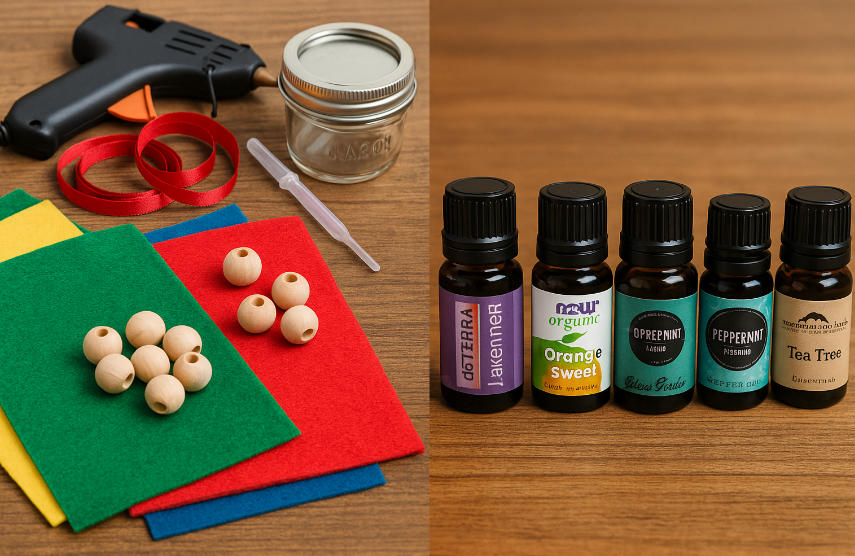
Where to buy craft essentials
Need felt, timber beads, droppers, or mason jars? You’ve got a few top options:
Craft stores like Spotlight or Riot Art & Craft offer felt sheets, ribbons, and jars.
Online retailers (Amazon, Etsy, or Catch) are great for buying bulk and hard-to-find supplies.
Discount shops like Kmart or Bunnings can be gold for budget tools.
DIY websites often bundle kits with everything included — perfect for beginners.
Pro tip: Ask your local hobby shop for off-cut fabric or sample beads — it’s cheaper and eco-friendlier!
Recommended brands for essential oils
You don’t need to spend a fortune, but cheap oils often smell like bathroom cleaner. Try these legit brands:
doTERRA – Known for purity, but pricey. Great if you're going all-natural.
Plant Therapy – More affordable and kid-safe blends.
NOW Foods – Budget-friendly and easy to find on Amazon.
Edens Garden – Mid-range with lots of scent variety.
Mountain Rose Herbs – Organic options with great reviews.
“Poor-quality oils break down fast in heat. A good oil won’t just smell better — it’ll last longer,” says Leah Moore, aromatherapy consultant at Essential Earth Living.
Material Safety in Hot Cars
“I once left a citrus-scented gel freshener on my dashboard through a 38°C Melbourne day. The next morning, my car smelt like burnt plastic and orange cough syrup,” recalls Tom Willis, a vehicle detailer with over a decade in the trade. Stories like his are not rare — and they underline a critical point: heat and poor ventilation can turn a sweet-smelling freshener into a silent health risk.
According to the Australian Department of Health, volatile organic compounds (VOCs) from synthetic air fresheners can become unstable when exposed to high temperatures. Elevated vapor pressure increases the release of irritants, potential carcinogens, and flammable compounds. Empirical testing in Australia has shown car cabins can exceed 70 °C within minutes on a 30 °C day, underscoring the volatility risk (RACV testing summary).
We spoke with Dr. Hayley Grant, a chemical safety specialist at UNSW, who warns: “Once internal car temps rise above 45°C — which happens fast in the Aussie sun — many air freshener materials begin to degrade. Some plastics leach chemicals with low exposure limits, posing real toxicity risks to children and pets.” For context on how fragrance chemicals are assessed in Australia, see AICIS’s categorisation guidelines and updates following the NICNAS transition (current guidance PDF; transition note).
Key risks in high-temp conditions:
Flammability of alcohol-based sprays or gels
Chemical degradation of plastic holders or synthetic oils
Build-up of airborne carcinogens in enclosed cabins
Lack of ventilation intensifying health risks over time
To minimise these effects, avoid placing fresheners directly in sunlight or on dashboards. Choose products certified by independent bodies and seek transparent labelling for ingredients and toxicity ratings. When in doubt, opt for natural alternatives like untreated timber beads or pure essential oils with low vapor activity. If you decide to purchase rather than DIY, consider individually sealed formats like Individually wrapped custom car air fresheners Australia to reduce uncontrolled evaporation in heat.
In a climate where your car can double as an oven, safety should always ride up front.
How long do DIY fresheners last?
Fragrance doesn’t last forever — and with DIY air fresheners, knowing how long they hold up can save you time, effort, and dodgy-smelling rides. For a quick durability rundown by form factor, see AllGoodsHub’s blog on car air fresheners, which discusses longevity ranges.
Average scent duration by base type
| Base Type | Avg. Scent Duration | Notes |
|---|---|---|
| Oil diffusers | 3–6 weeks | Strong, slow release |
| Gel air fresheners | 2–4 weeks | Good for small spaces |
| Spray air fresheners | 2–3 days | Instant but short-lived |
| Reed diffusers | 2–5 weeks | Needs regular flipping |
For longer-lasting scent, opt for carrier oil-based diffusers or gel bases. Spray-based types are best for quick refreshes.
How to recharge or refill scents
Running low? Don’t chuck it — recharge it!
Add 5–10 drops of essential oils to your old diffuser.
For gel refills, melt a fresh mix of gelatin + essential oils + salt.
Refill spray bottles with a mix of vodka, water, and fragrance oil (about 20 drops per 100ml).
Candle wax types? Add melted wax mixed with oil into containers and let set again.
“Refills save cash and waste — plus you can change the scent without tossing the whole setup,” says Aussie DIY YouTuber Leah Jameson. Want a professional refill route instead? AllGoodsHub offers low-MOQ options such as custom car air fresheners starting at 50 pieces.
Signs your freshener is "expired"
Scent is barely there — the fragrance is just… gone.
Discolouration or weird layering — sign of ingredient separation.
Mold or moisture spots — especially on felt or natural wood.
Chemical smell replacing the original scent — could mean it’s degraded.
Expiration date reached (if you're reusing store-bought bases).
Natural and eco-friendly options
Making your own car air freshener isn’t just about smelling good — it’s a great way to reduce waste and support sustainable choices without breaking the bank. If you eventually scale up or gift them, read AllGoodsHub’s overview on custom air freshener packaging and materials.
Using biodegradable felt or fabric
Biodegradable felt and plant-based fabrics are top picks for eco-conscious DIYers. Unlike synthetic materials, they break down naturally over time and are often made from natural fibers like hemp or bamboo.
Look out for:
Recycled felt blends
Sustainable textiles with minimal processing
Felt alternatives like cork fabric or cotton-linen blends
Choosing the right material not only reduces your carbon footprint but also makes your car freshener guilt-free from start to finish.
Sourcing ethical essential oils
Ethical essential oils are harvested with fair trade, organic, and cruelty-free standards in mind. Supporting responsible harvesting ensures communities and ecosystems aren’t harmed. In Australia, many essential-oil constituents used in consumer goods fall under AICIS oversight (see fragrance chemical rules), so buy from suppliers who publish compliance details.
Check for certifications from trusted bodies (e.g. ACO, USDA Organic).
Choose small-batch essential oil suppliers with transparency.
Avoid “bargain” oils – they’re often diluted or poorly sourced.
As Aussie aromatherapist Leah Carter puts it, “A good oil starts with a good grower — you smell the ethics.”
Avoiding synthetic additives
If you’re aiming for clean air inside your car, avoiding synthetic additives is a must. These can include artificial fragrances, preservatives, or even sneaky color additives. Current indoor air research continues to evaluate how fragranced environments interact with indoor chemistry and human perception (2025 assessment of VOC levels vs. perceived strength).
Stick to natural ingredients like pure essential oils
Check labels for non-toxic or chemical-free claims
Homemade mixes? Keep ‘em preservative-free
Tip: If it smells “too strong” or “too sweet,” chances are it’s loaded with synthetic junk. Trust your nose.
Reusable container designs
A good DIY air freshener doesn’t need to end up in landfill. Use refillable containers that are built to last. To see how brands package sustainable fresheners, browse custom eco car air fresheners.
Glass containers: great for holding baking soda or oil blends
Metal tins: durable and heat-resistant
Plastic alternatives: try bamboo or wheat straw resin containers
Swap single-use for sustainable packaging and you’ll save cash long-term too. Nothing beats a fresh scent in a slick eco-friendly design.
Compostable packaging ideas
| Material Type | Compost Time | Composting Type |
|---|---|---|
| Seed paper wrapping | 30–90 days | Home compost |
| Cornstarch bags | 90–180 days | Industrial composting |
| Sugarcane pulp trays | 60–120 days | Home compost |
Local Aussie brands to support
Buying from Australian brands means lower emissions, better transparency, and supporting local legends. Here are a few doing it right:
ECO. Modern Essentials – certified organic essential oils, based in QLD
Biome – all-in-one stop for sustainable products
The Goodnight Co. – essential oils & blends made with Australian ingredients
Supporting small businesses in Oz keeps your DIY dollars doing good locally. Shop smart, support local, smell amazing.
Conclusion
So there you have it — making your own car air freshener is as easy as chucking a few things together and letting the scent do the heavy lifting. No more chemical pong or shelling out ten bucks for a tree that fizzles out in days. If you’d like to turn your favourite design into a gift or promo item, AllGoodsHub offers custom car air fresheners with your logo and ultra-low MOQs for trials.
As Aussie eco-designer Clare Mooney puts it, “DIY is less about saving money and more about creating things that feel personal and real.”
Grab your oils, pick your vibe, and give it a go — your car (and your nose) will thank you for it. For further reading on safety questions, see AllGoodsHub’s evidence roundups: are car air fresheners bad for you and can car air fresheners make you sick.
What essential oils are safe for cars?
Most essential oils are fine in small amounts, but it's best to go for scents that aren’t too overpowering in a confined space. Good picks include:
Peppermint: Helps with focus while driving
Lemon or orange: Bright and refreshing
Lavender: Calming for stressful commutes
Avoid cinnamon or clove — they can be too intense in heat.
How long do homemade car air fresheners last?
On average, they last 2 to 4 weeks, depending on:
The base material (felt, wood, gel, etc.)
Oil quality and amount used
How hot your car gets during the day
Some people top them up weekly with a few drops of oil for a fresh hit.
Can I reuse the same felt or beads?
Yes! Timber beads and felt shapes soak up oils really well and can be refreshed again and again. Just wait until the previous scent fades, or mix carefully to avoid odd scent combos.
Is it cheaper to DIY than buy commercial air fresheners?
In the long run — absolutely.
A bottle of essential oil lasts months
Materials like felt or beads are inexpensive
You can reuse or refill instead of throwing away
You might spend a little up front on supplies, but they’ll stretch a long way.
What materials won’t melt in a hot car?
Safe bets include:
Natural timber or hardwood beads
High-quality wool felt
Mason jars or metal vent clips
Avoid cheap plastics or glues that soften in heat.
Can I make air fresheners without essential oils?
You can, but they won’t be as effective. Some alternatives:
Scented herbs or dried citrus peels
Fragrance oils (though not as natural)
Infused baking soda in a jar
Still, essential oils are your best bet for both scent strength and longevity.
What’s the best base for long-lasting scent?
Carrier oils (like fractionated coconut oil) hold onto scent longer than alcohol or water-based sprays. Gels are also great for slow diffusion, but can be trickier to make at home.
How do I stop my DIY air freshener from leaking?
Use absorbent materials like felt or beads
Keep containers upright and sealed if liquid
Avoid overloading with oils
Test placement before hanging near fabrics
Can I sell homemade car air fresheners?
You can, but do your homework first. Check:
Local business licensing rules
Labelling requirements for scented products
Insurance (in case of allergic reactions)
Plenty of small makers start out at markets or on Etsy — it’s a great side hustle if you’ve got a nose for scent.

Leave a comment